Undergrad Alumni of the D-Lab
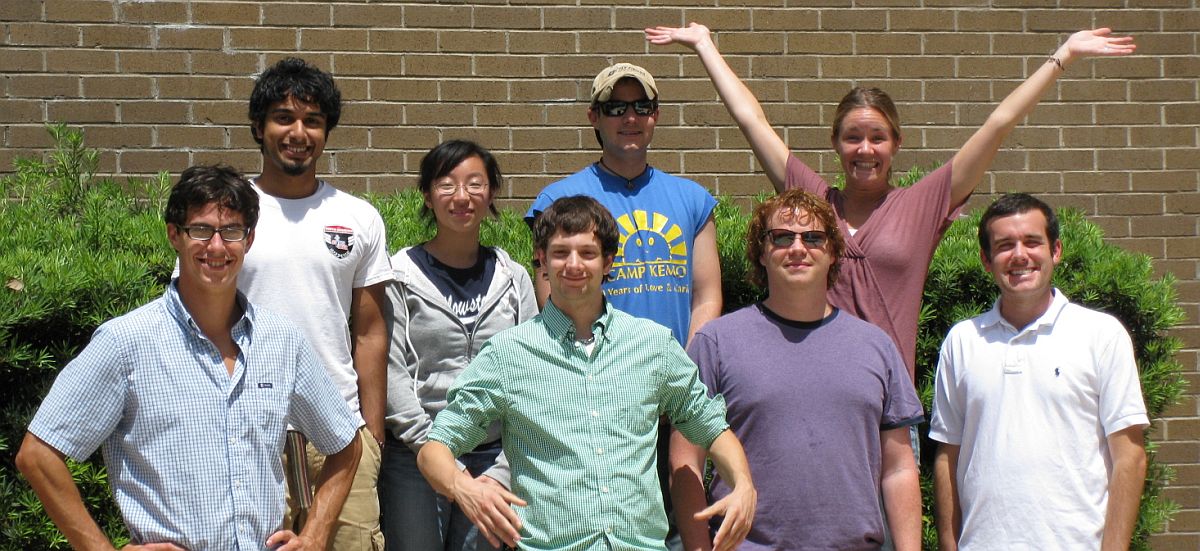
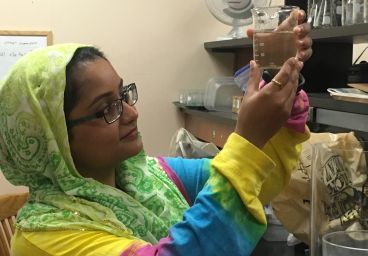
Syeda came to the lab from Claflin University as a part of SC-ADAR, an NIH-funded research training program in the biology of aging. In her first summer with us, Syeda glued together two of the lab’s major interests, working on both aging and vision in Daphnia. In her second summer, she wanted to express things differently, so we dug some of Cameron’s samples out of the depths of a -80 freezer and she used qPCR to measure DNA methyltransferase mRNA abundance at different ages in long- and short-lived Daphnia. Syeda is now pursuing a graduate degree in biomedical engineering.
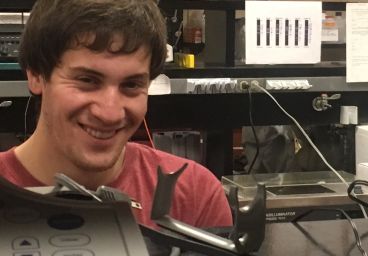
John came through Jeff’s advanced Evolutionary Biology course with an unusual career plan for a biology major -- he's going to law school (Fordham, to be specific). Which is great, because we need more lawyers. Ok, we need more lawyers who are actually scientifically savvy, and understand the difference between a null hypothesis and a null hippopotamus. We look forward to the day where he is arguing before The Nine and explains to them how to build a Cryptophyte plastid phylogeny using rbcL sequences. Along the way, John occasionally tested very creative hypotheses about whether lab protocols can be “improved,” and we hope to read of similar experiments in evidentiary protocols.
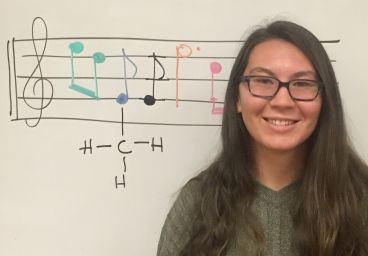
Joelle was an outlier in the haplotype network of the D-lab, working with neither Daphnia nor Cryptophyta. Instead, she worked with notes. And rests. And tempo, fermatas (fermatae?), and maybe even a SFORzando or two. After taking “Chords and Codons” with Jeff and Reg Bain of USC's Experimental Music Studio, Joelle did a data sonification project for her honors thesis. She sonified epigenetic data, allowing someone to ‘hear’ an epigenome. As it turns out, the divergence between the human and chimp epigenomes sounds exactly like Strauss's Also Sprach Zarathustra. J/K. But wouldn’t it be just AWESOME if that were true? (Props to the Kubrick fans.)
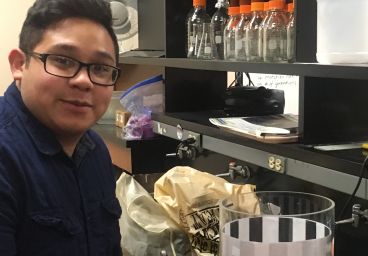
After a false-start as a cryptophycologist, Adrian’s true colors as an animal behaviorist emerged. He completed an honors thesis and Magellan project testing whether eye size influences visual function. It does! And it does not! Ah, well -- what scientist hasn't gotten a mixed answer to what started out as a very clear, simple question? Adrian may be done with Daphnia, but he isn't done behaving. After graduating, he switched coasts to pursue a Ph.D. in animal behavior at UC-Davis.
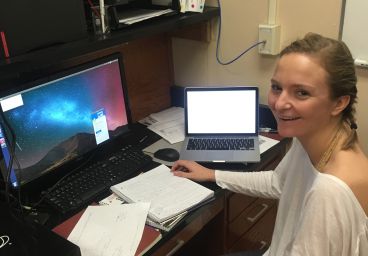
Hailey is one of those rare people who understand both real living organisms, and has a penchant for computer coding. A joint Biology/CS major, Hailey is a veteran of Jeff’s Ecology and Evolution course, and kept thinking that simulating mutation was much better than becoming a mutant. She joined our project on Mutational Music, and developed our basic (well, python, not basic) mutation simulator. After graduating, she got snapped up by Boston Biomedical where she is now a data coder for their biotech consulting group.
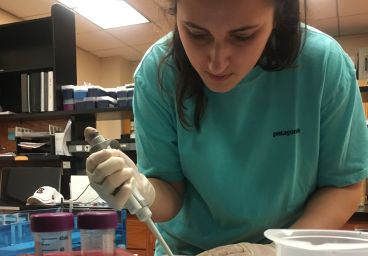
Ashley was in Jeff’s advanced evolution class (with Patrick and Adrian and Peter, too), and afterwards wanted to find out more about what makes genes tick. So while most of the Cryptophycologists focused on their weird kind of photosynthesis, Ashley brought the lab back to the basics of primary producers. She developed primers for and sequenced RuBisCO (not Nabisco), a critical gene for normal photosynthesis that lies on the plastid. After graduating, she headed back to Cincinatti, where she's pursuing a career as a medical lab technician.

Allison was our fourth(?) visionary undergraduate. She worked on a project to compare selection on eye size across different species of Daphnia, though her focus was on Daphnia ambigua. This means that she was the Lab’s expert in photography and ImageJ, a skill we sorely miss. (We'll also miss her acumen at the next Biology Bowling Challenge. STRIKE! STRIKE! STRIKE!) After graduating, she considered a variety of careers, and is now pursuing a Ph.D. in Genetics at (shhh!) Clemson.

Campbell spent much of his time slowly rotating in the lab (but never twirling, twirling, twirling towards freedom). Campbell was interested in just how Daphnia vision works, and was the first person to demonstrate our critters' have an optomotor response. To do this, he designed and had built The Contraption, a circular Daphnia tank surrounded by psychedelic rotating stripes. After graduating (where he was named Biology’s Outstanding Senior), he decided to head to med school.
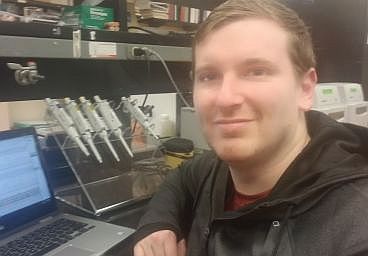
Matt graduated with what may be a record-setting number of credits in his degree. We’re not sure if there are any classes at USC Matt didn’t take. He worked with Trenton to study how DNA methyltransferases actually function, and to do that there was a lot of cloning and cloning and cloning -- the molecular biology kind, not the Daphnia kind. Matt’s also a Navy veteran of the war in Afghanistan. (Don't ask how the Navy got their ships into a land-locked country ... that’s TS.) Matt didn't leave after graduating: he levelled-up to being a grad student in the lab.

Mason joined the lab at a time of crisis, and was instrumental in our recovery from The Debacle. He then decided to leap onto the hottest bandwagon in biology: epigenetics. Ninety-five percent of his time was spent troubleshooting methods of measuring genome-wide and gene-specific methylation. “No conundrum!” Mason said, and eventually he examined age-dependent patterns of methylation in Daphnia. After graduating in 2015, Mason went to med school at USC/Greenville.
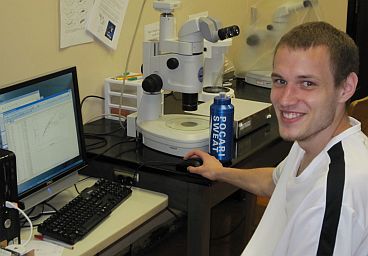
Stephen worked on two related projects. First, he discovered sexual dimorphism in eyes occurs throughout the Daphnia genus, but is variable among species. He presented this work at the international Evolution 2014 meeting in Raleigh, NC. In his other project, he sought to determine whether opsin expression changes from day to night. In 2015, he finished his degree and embarked on a Ph.D. in evolutionary genomics at Kansas State.
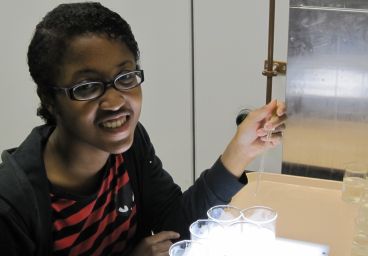
When Randi was a student in Jeff’s BIOL 301 class, she sat in the front and politely pointed out every single mistake he made that semester. Randi's project addressed methyl farnesoate, a hormone that regulates sex development in Daphnia. The trouble is, it seems not to do what it’s supposed to do in every clone. Using a classic dose-response approach, Randi figured out just what it takes to become male (if you’re a Daphnia, that is). She is pursuing a career in medical technology.
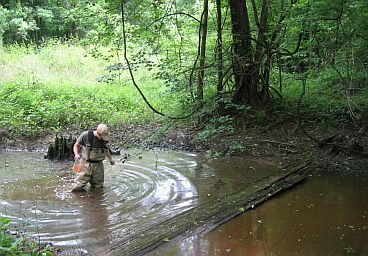
Jay launched our fieldwork at Congaree National Park. He counted endless samples, typed them with allozymes, and developed GIS maps of our populations. His work described the demography of Daphnia in sections of Congaree with different probabilities of flooding. After graduating, he earned a graduate degree in environmental biology at The Citadel. He is now part of the SC ecotourism industry, working as a naturalist with Nature Adventures in Mount Pleasant. See him at Jay's Nature Blog.
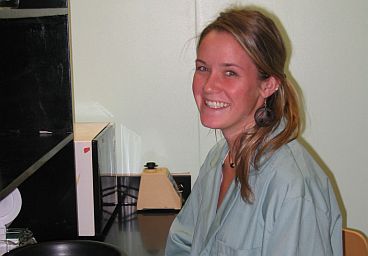
When she wasn't organizing food drives to benefit Harvest Hope, Christine worked on a project to evaluate molecular evolution of aging-related genes in long- and short-lived Daphnia. The main genes she dealt with were Cheerio, Rpd3, EcR and INDY. You could often find her at the computer patiently phasing her sequences. And when Kevin wasn't paying attention, she changed the music to the Beatles. She is now teaching biology at West Mecklenburg High School in Charlotte, NC.
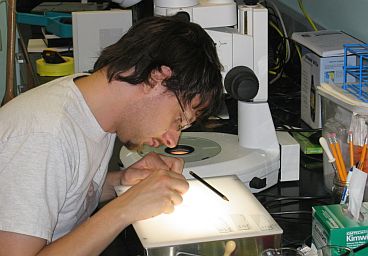
Chris joined the lab as part of our REU program in the Summer of ’08. He learned to count algae and worked on a project examining trade-offs in resource exploitation among clones of Daphnia adapted to different resource environments. He presented his research at the international meeting of the Society for Integrative and Comparative Biology. After graduating from Northeastern Illinois University, he came back in the lab as a grad student with a vision.

Andy was fascinated by stem cells. So of course he came to us, since freshwater ecologists are well-known for stem cell expertise. Andy was co-advised by Rekha Patel, who actually is part of our cell and molecular program. Working primarily with embryonic cells (“primarily,” get it?), Andy holds the World’s Record for longest-lived Daphnia cell, discovered many conditions under which cells will not divide, and won 1st Prize for his presentation at Discovery Day. After graduating, Andy joined the Patel Lab, but he’s still one of us, continuing work on Daphnia.
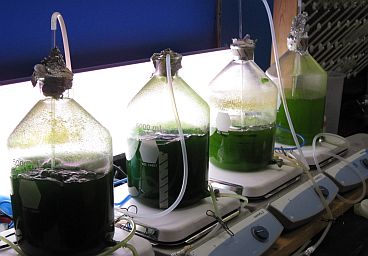
Danny had a particularly amazing introduction to ecology and evolution: several weeks in Ecuador, including an expedition to those islands off the coast. Everyone in the lab was jealous, of course. But Danny still came back to work on humble Daphnia, though he had to go international for his clones. He worked on growth and respiration reaction norms with Finnish and German D. magna. After graduation, he went to Boston University to pursue a graduate degree in international public health.
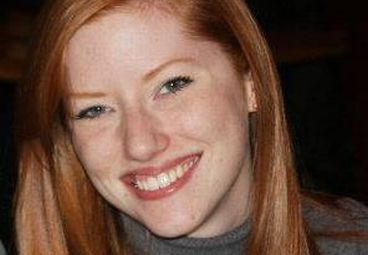
Maddy survived Jeff’s Biol 301 class (Some of the undergrads really do make it through) and was interested enough to join our crew. Working her schedule around the demands of homeownership, Maddy compared gene expression variation in different Daphnia ecotypes. Is it an artifact of sequence variation? Is it a consequence of getting Mowgli wet? After her undergraduate time, she stayed with us to get an M.S. degree in bioinformatics. She’s now teaching high school in at Seven Lakes in Katy, Texas, where she coaches their nationally-ranked Science Olympiad team.
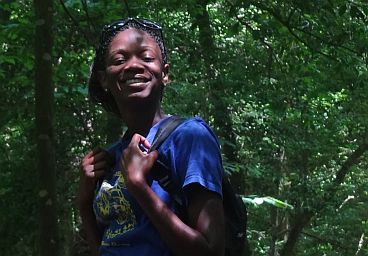
Tiesha was our second undergrad to work on a vision project. She went out to Congaree National Park and sampled populations of Daphnia to find out whether there was a connection between eye size and reproductive success. If you try to ask her a trick question when she gives a presentation, watch out: she can turn it around back on you in a flash. Tiesha is a coauthor on a paper in the Journal of Evolutionary Biology. After her summer with us, Tiesha became a nursing student at Francis Marion University.

Darius is also a veteran of Jeff’s 301 class, and joined us on his way to becoming a pharmacist. Seeing as how the FDA approval process for Daphnia drugs is even slower than that for humans, Darius embraced a comparative project. He looked at the allometry of eye size in a dozen species of Daphnia. In the course of this project, Darius has photographed hundreds of Daphnia eyeballs. Darius now works in the pharmaceutical industry.
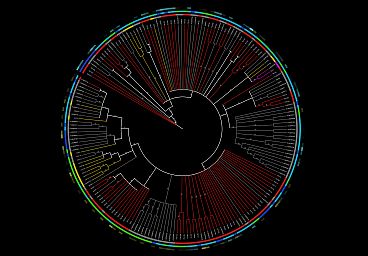
Tim also made it through Jeff’s Ecology & Evolution class, and joined the lab in a project examining DNA sequence variation among arthropods in genes associated with aging. He now runs an organic farm in Northern California. You might guess he was the only guy in the lab to have a beard, and you’d be right.

Caitlynn was the first undergraduate to do an ethics project with Jeff (not that the others were unethical, of course). She did an extended study of public attitudes toward coastal management issues from the perspective of environmental ethics as part of her Marine Science major. After graduating, she pursued a graduate degree in marine policy at Duke.

Mat did an extensive analysis of population genetic structure of Daphnia at Congaree National Park, genotyping hundreds of clones for a suite of microsatellite markers, and presented his research at the international Evolution meeting. He’s a microsatellite expert, unfazed by third primers, third alleles, or the third shot of Red Bull that kept him going at 3 A. M. Mat spent a couple of years as a researcher at NIH, and in 2014 began an M.D./Ph.D. program at the University of Florida.
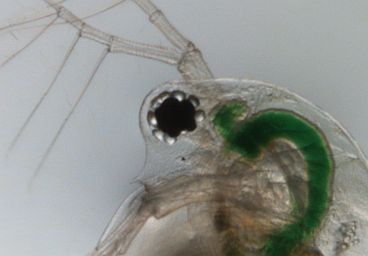
Cameron looked at differences in the physiological age of individuals and examined the expression of genes involved in key aging-related molecular pathways. He spent a lot of time optimizing qPCR reactions for different genes, and became best friends with our Bio-Rad machine along the way. After graduating, he joined the M.D. program at MUSC (and finished in 2016: He's Dr. Bell, now), but he can still wield a pipette in a fight. He says he might pursue a fellowship in Cards following his internal medicine residency. I think he means cardiology, but he's got a good poker face.

Ed came to us from Vanderbilt University as part of our REU program in integrative evolutionary biology. He worked on a project looking at microsatellite variation in the salt marsh grass Spartina alterniflora, and braved the famously hot Columbia summer to go cycling when he wasn't in the lab. Ed has since graduated from Vandy and went on to pursue a Ph.D. in evolutionary biology at the University of Georgia.

Alice joined our group as a part of the REU program in 2009, working to characterize microsatellite differences between Daphnia pulex and D. pulicaria. Somehow, Alice managed to get her PCR reactions to work despite having weirdness in her primers. Alice graduated early from Tulane, pursued a post-baccalaureate research internship at the National Institute of Environmental Health Sciences, and then went to medical school at the University of Chicago.
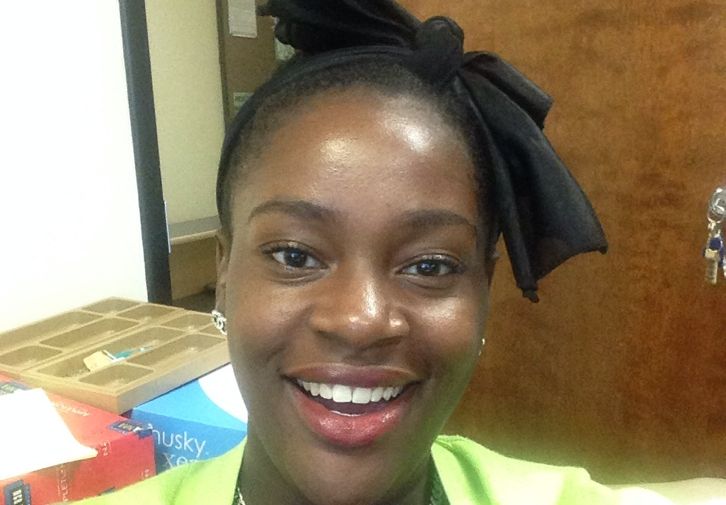
Allaina responded to our job ad for an Algae Goddess. Really, who wouldn't want a job like that? The job primarily involved responding to the entreaties of Ankistrodesmus for such things as nitrate, K, Se, and Vitamin B12. However, there was a dark side. Every day, the Daphnia demand their sacrifice, and Allaina delivered the beautiful greens cells which sustain them. After completing her psychology degree, Allaina moved on to graduate school to pursue an M.A.T. in Special Education with a focus on learning disabilities and emotional behavioral disabilities. She is also the director of Challenging Horizons, an after school program.
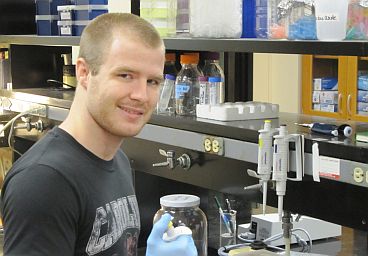
Chris was interested in understanding physiological regulation of aging. Dietary restriction usually extends lifespan and slows the aging process. But how does temporally limited dietary restriction influence aging? Does applying to med school make you age faster? And when he was in the lab, he was mostly talking about med school applications. It must have paid off, since in 2014 he joined the entering class at the University of Virginia School of Medicine.

Having vanquished The Rejected One, the Chosen One has graduated and moved on to parts unknown. Perhaps she has returned to the slimy log whence she came, perhaps she simply decided that she had given enough to science, and was ready for retirement. Wherever she is, we wish her good fortune.
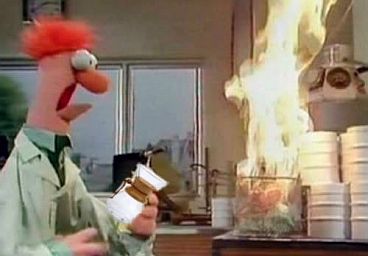
BvB was an integral vessel in the lab, and despite being prone to shattering safety standards, we couldn't have done our early life tables without him. Frequently, he worked in collaboration with Falcon F. Tubessen to ensure that the Daphnia had a good place to live. His time with us was sadly temporary, and now he is a graduate student in the lab of Dr. Bunsen Honeydew. Currently BvB is pioneering advances in cloning he learned from Daphnia, and working on diverse side projects including banana sharpening and gorilla detection.